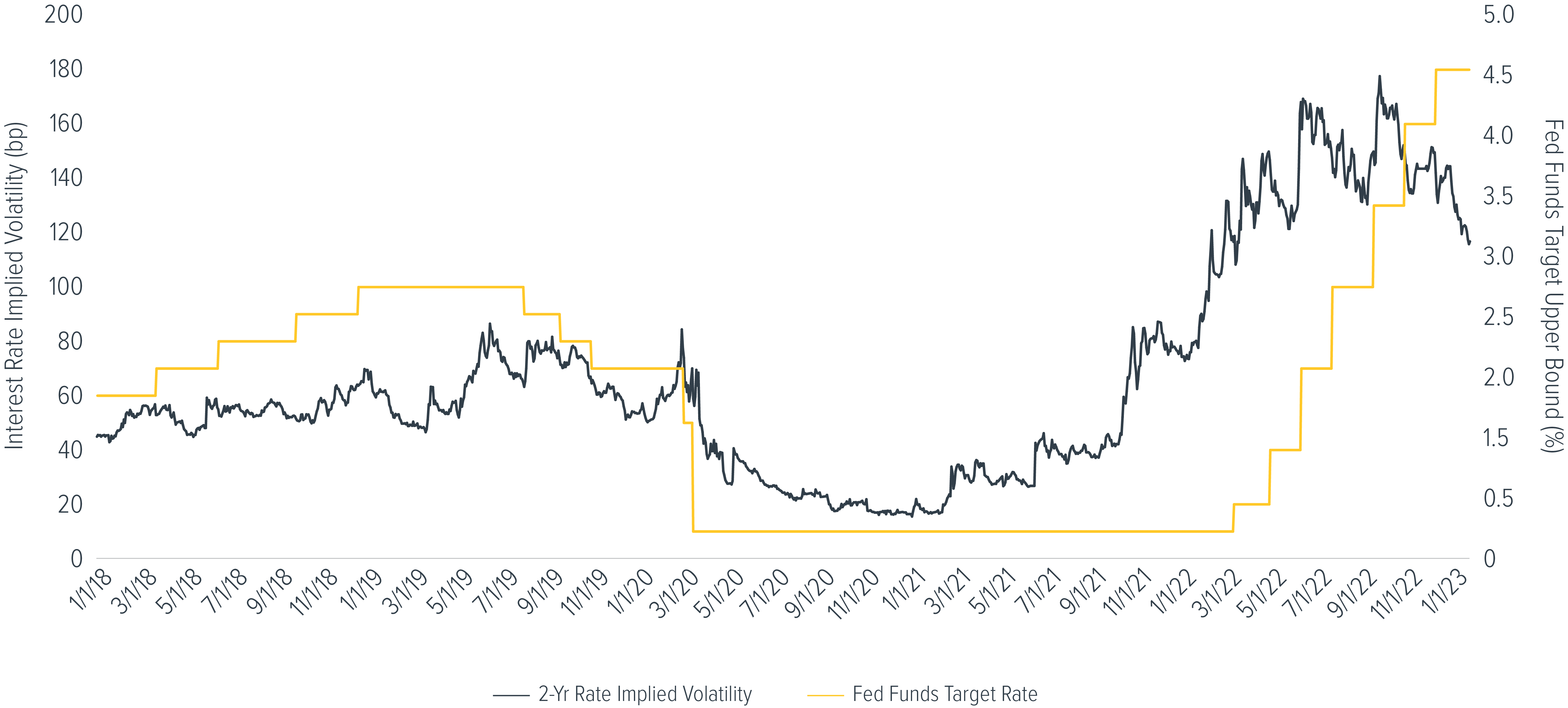Expected interest rate volatility has fallen 28 points so far this year
The financial markets are predicting less volatility in interest rates during the coming months—which, if true, could also mean a smoother road for stocks, bonds, and investors’ portfolios overall.
To see why, check out the chart below. It shows the amount of day-to-day volatility that investors expect to see in the two-year Treasury yield over the next six months on average, as measured by the two-year Treasury price volatility. The key takeaways:
- Expected yield volatility soared in 2022 as the Fed hiked rates, peaking in September and staying elevated. At year-end, investors were looking for the yield on the two-year Treasury note to fluctuate by nine basis points per day, on average. As the chart reveals—and as we highlighted in our fourth quarter report — movement of that magnitude for a short-term Treasury note would be extraordinarily volatile.
- Recently, however, those volatility expectations have fallen sharply—down 28 volatility points (vols) so far this year to their lowest level since March 2022. Back then, the Fed had just raised interest rates by 25 basis points, on its way to a total increase thus far of 425 basis points. Investors now expect the two-year Treasury note yield to fluctuate by seven basis points per day, on average, over the next six months.

Source: Bloomberg, as of 01/27/2023
Here’s why that’s a big deal. Stocks’ valuations and expected returns are determined largely by the yields on risk-free assets such as the two-year Treasury note, which is backed by the full faith and credit of the U.S. government. So if investors think the yield on that seemingly stable, risk-free asset is going to fluctuate wildly—as they did last year—it becomes virtually impossible to value stocks (and many other assets) with any degree of confidence.
The upshot: As volatility expectations come down to more historically normal levels, investors gain much-needed clarity about the likely direction of stock prices going forward—and should become more willing to buy stocks and other risk assets.
In fact, it’s already happening: The S&P 500 TR Index is up 14.3% from the lows of last year as of January 27, 2023.
That said, risks remain. Expected volatility will need to fall below 80 vols to be back in the range of normal (approximately five basis points per day). The good news for investors: It’s moving in the right direction.
This commentary is written by Horizon Investments’ asset management team.
Past performance is not indicative of future results. The volatility of an account may be greater or less than that of an index.
Nothing contained herein should be construed as an offer to sell or the solicitation of an offer to buy any security. This report does not attempt to examine all the facts and circumstances that may be relevant to any company, industry, or security mentioned herein. We are not soliciting any action based on this document. It is for the general information of clients of Horizon Investments, LLC (“Horizon”). This document does not constitute a personal recommendation or take into account the particular investment objectives, financial situations, or needs of individual clients. Before acting on any analysis, advice, or recommendation in this document, clients should consider whether the security in question is suitable for their particular circumstances and, if necessary, seek professional advice. Investors may realize losses on any investments.
The investments recommended by Horizon Investments are not guaranteed. There can be economic times when all investments are unfavorable and depreciate in value. Clients may lose money.
Asset allocation cannot eliminate the risk of fluctuating prices and uncertain returns. All investing involves risk of loss, and in periods of market growth, risk mitigation strategies can be expected to lag in performance behind equity strategies that do not focus on risk mitigation.
This commentary is based on public information that we consider reliable, but we do not represent that it is accurate or complete, and it should not be relied on as such. Opinions expressed herein are our opinions as of the date of this document. These opinions may not be reflected in all of our strategies. We do not intend to and will not endeavor to update the information discussed in this document. No part of this document may be (i) copied, photocopied, or duplicated in any form by any means or (ii) redistributed without Horizon’s prior written consent. Forward-looking statements cannot be guaranteed.
The S&P 500 or Standard & Poor’s 500 Index is a market-capitalization-weighted index of the 500 largest U.S. publicly traded companies. References to indices or other measures of relative market performance over a specified period of time are provided for informational purposes only. Reference to an index does not imply that any account will achieve returns, volatility, or other results similar to that index. An index’s composition may not reflect how a portfolio is constructed in relation to expected or achieved returns, portfolio guidelines, restrictions, sectors, correlations, concentrations, volatility or tracking error targets, all of which are subject to change. Individuals cannot invest directly in any index.
Other disclosure information is available at www.horizoninvestments.com.
Horizon Investments and the Horizon H are registered trademarks of Horizon Investments, LLC
©2023 Horizon Investments LLC

